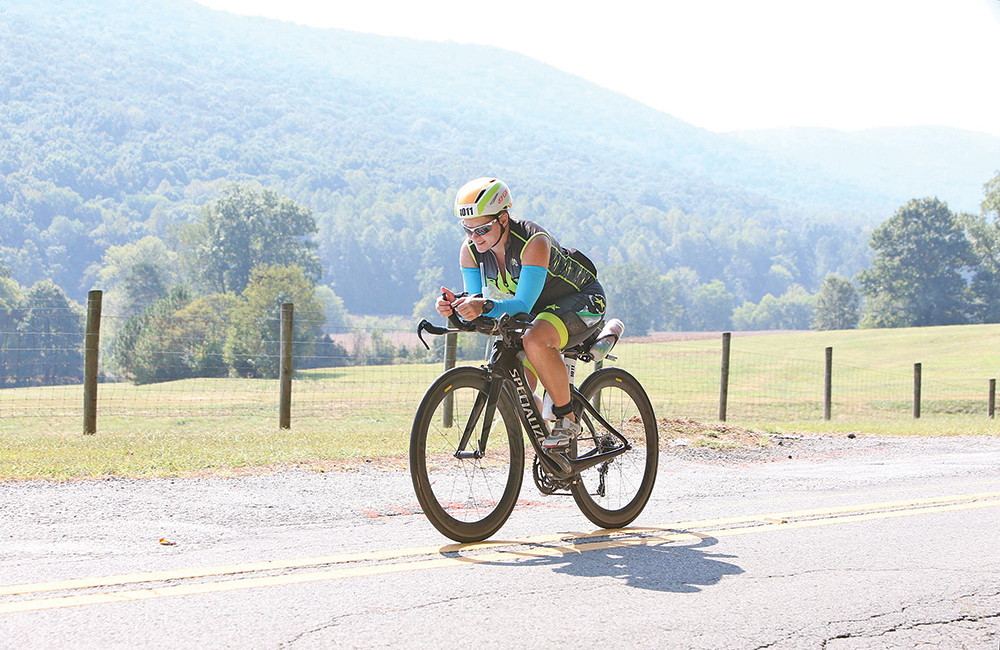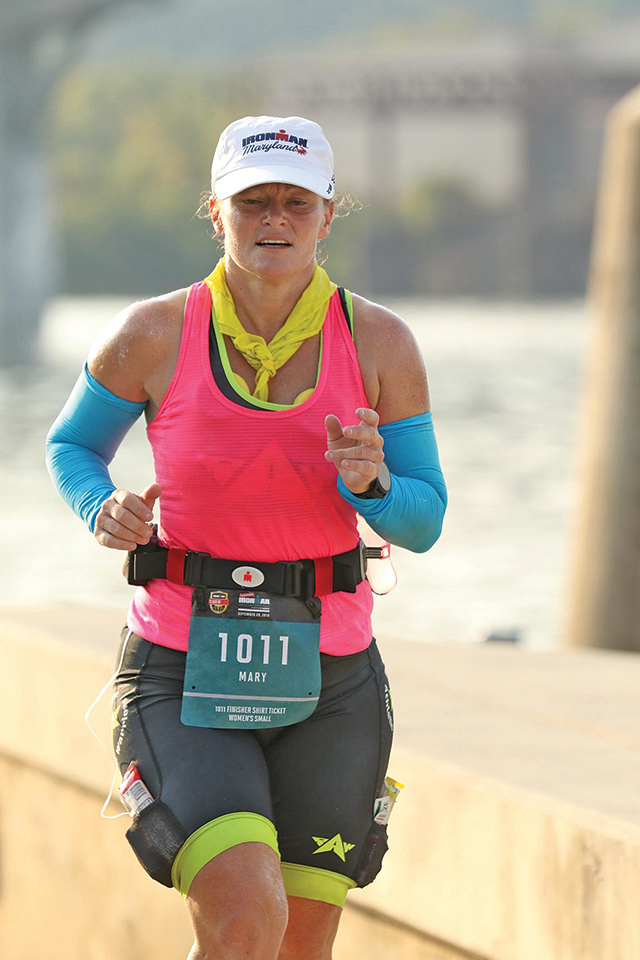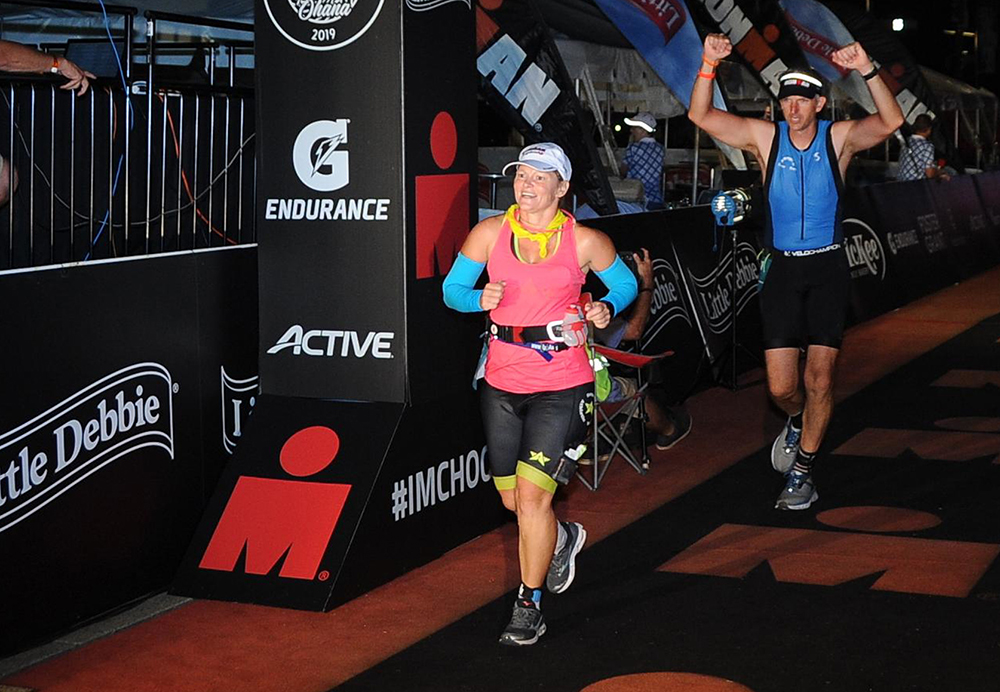Pushing to the limits: How Mary Kalich prepares for an Ironman Triathlon


On a recent Friday morning, Mary Kalich began her day with a seven-mile run. A 40-minute cardio workout on an elliptical and rower got her warmed up for a strength-training CrossFit class. Her routine ended with a yoga class.
For most active people, that would represent a week’s worth of exercise.
For Ms. Kalich, that’s simply a day in the offseason.
To compete in Ironman Triathlon races requires year-round dedication, a willingness to sacrifice and to push beyond what the human body seems capable of enduring.
The race is a marathon on steroids — a 2.4-mile swim, a 112-mile bicycle ride, culminating with a 26.2-mile run. On average, the race takes most competitors at least 12 hours to complete.
“I love the challenge,” said Ms. Kalich, 47, who lives in Mattituck. “I love the training. I love how healthy it makes me and working toward a big accomplishment. I’m very goal-oriented. This is a huge goal.”
The long-term goals of completing a race, she said, as well as the short-term goals, keep her motivated, as she builds on her workouts each week to prepare for the ultimate challenge.
Most recently, on a blistering day in late September, Ms. Kalich completed the Ironman Chattanooga race in Tennessee. It was her third Ironman Triathlon and she plans to run a fourth in 2020.
Like most Ironman competitors, Ms. Kalich’s journey began more than a decade ago, when she first started racing in local triathlons.
“You go slow in the beginning and you don’t really know what you’re doing,” she said.
She has also participated in long bicycle rides for charity, which put her on the right track for triathlons. Biking is her strength, she said, and swimming is her weakest component.
She admits that her husband, Nate, and son, Micky, a sophomore at Mattituck High School, thought she was a bit nuts when she began training for her first Ironman race in Maryland in 2017.
On top of the challenges anyone would face while training, Ms. Kalich is also diabetic. She uses an insulin pump daily to constantly maintain her proper blood sugar levels.
“When you are going through extreme stress, as you would in this case, your body acts differently,” she said. “It can be really challenging and really scary. There’s a high likelihood of issues while you’re doing a race and you need to be able to address them while you’re biking.”

Pressing a button to deliver a boost of insulin when needed while bicycling in competition presents a unique challenge. The races are so long and require so much energy, she’s always stocked with different types of food she can eat. Nature Valley granola bars are one of her favorites. She must be aware of exactly how much sugar is in a certain food she’s eating in order to administer the correct insulin dosage.
She doesn’t take the pump in the water for the first leg of the triathlon. She’ll pick it up at a table where there are often other pumps from fellow competitors who face the same adversity.
She said people who face certain challenges are often inspired to pursue extreme adventures, so she’s not surprised when she meets other diabetic athletes.
“Why do I do this? Because I love the structure and I love having to have that focus,” she said.
The race in Chattanooga presented a particularly tough set of circumstances due to the high temperature, which was around 95 degrees. The races each have certain cutoff times that a competitor must finish by. For Chattanooga, the time was 16 1/2 hours. She knew her strategy was to take it as slowly as possible while maintaining enough speed to finish. Water breaks were constant, not only for hydration but to cool her body. She would pour water all over herself and her special arm sleeves were designed to soak in the water and keep the body cool until the next stop.
She needed almost the entirety of the allotted time, finishing the race in 16:16.
About 16% of the competitors that signed up didn’t even start the race and another 24% who started didn’t finish. The percentage of racers who didn’t finish was the third-highest at Ironman races dating back to 2012, according to data compiled by the website CoachCox.
“You can’t push too hard,” Ms. Kalich said.
At the end of a race, despite the exhaustion of hours and hours of stress, Ms. Kalich said there’s a bit of a high and her body is still running on adrenaline.
“Your body stays on for like another full day and then you become done and crash,” she said.
The offseason is a critical time to allow her body to recover and then rebuild her strength for the next race. She said training begins about nine months before a race and goes into full gear about six months out. The training peaks about three to four weeks before the race, allowing the body a brief respite before going through the grueling competition. To limit wear and tear, she never runs the full marathon distance while training.

While Ms. Kalich doesn’t have a coach, she often trains with friends, who join her on bicycle rides and swim with her. Open water swimming, in particular, is critical to do with someone else, she said, in case of some type of emergency.
Ms. Kalich began her career working in IT management. She worked on Wall Street with her husband, who’s a bond trader. The couple met while attending Massachusetts Institute of Technology.
She recently earned a law degree, although she’s not currently practicing. Ms. Kalich said she has the benefit of time when it comes to training, since she doesn’t work full time. She volunteers with North Fork Community Theatre, where she’s currently directing the spring production of “The Producers.”
When training, she’ll often begin riding her bike early in the morning. A round-trip ride from her house to Orient Point is 50 miles. She’ll often make the trip twice in one day.
Every once in a while she’ll get a curious glance from someone experiencing déjà vu.
“People are like, weren’t you here this morning?” she said. “I’m like, yeah!”
Top photo caption: The 112-mile bicycle ride is the second leg of an Ironman race. (Courtesy photo)








